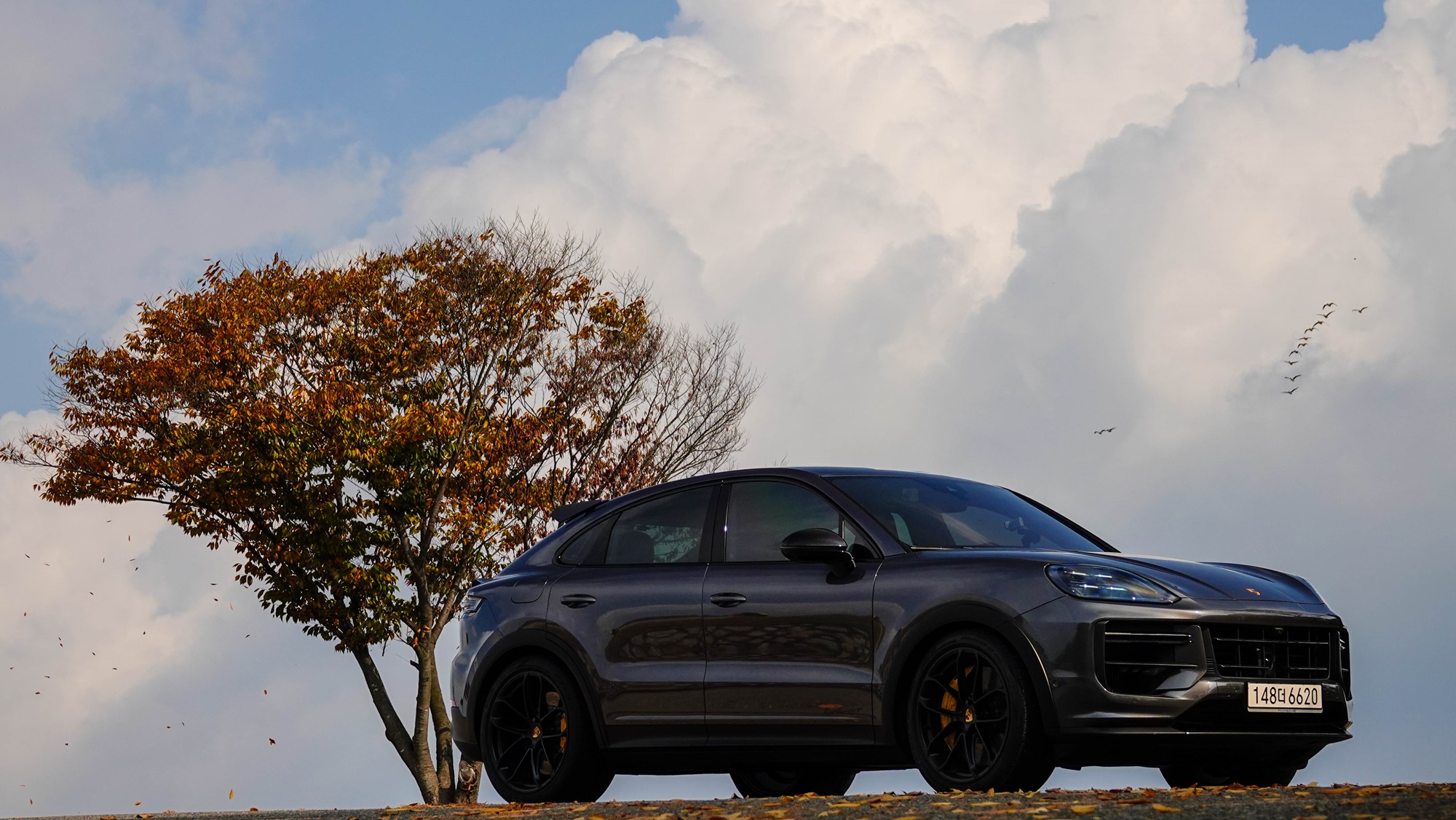
The Porsche Cayenne Turbo GT, a knife is scarier when it’s in its sheath.
This is the thought that crossed my mind after driving the new Cayenne Turbo GT. With an astonishing 673 horsepower, it would be nothing short of rude to openly flaunt such power on public roads. This is a car that requires a humble approach, one that is handled with restraint.
That’s easier said than done. It’s as if you’re sharing a room with Cleopatra and you’re expected to behave yourself. Despite the challenge, that’s the proper way to treat this vehicle.
The new Cayenne is a third-generation facelift model. It will be available in Korea in three variants: the Cayenne, Cayenne Coupe, and Cayenne Turbo GT. With 25,000 units sold by July this year, the Cayenne has proven to be a popular model. It is certainly a cash cow for Porsche.
The top-of-the-line model, the Cayenne Turbo GT, is based on the Coupe. With dimensions of 4,932 x 1,995 x 1,648mm and a wheelbase of 2,895mm, it offers a luggage space of 538 liters that can expand to 1,486 liters with the rear seats folded down.
The 12.6-inch full-digital instrument cluster is a first for Porsche, and an optimized head-up display is offered as an option. A 12.3-inch Porsche Communication Management (PCM) monitor has been placed in the center fascia, allowing users to even watch YouTube videos.
A 10.9-inch monitor for the passenger seat also catches the eye. Passengers can enjoy their own entertainment without being seen by the driver. In fact, the passenger-side monitor is invisible from the driver’s seat. A total of four monitors—including the head-up display—fill the front interior. While the growing number of displays is impressive, we need to think more about what content will fill these screens.
The gear lever for the 8-speed automatic transmission has been raised above the dashboard, allowing for more spaciousness in the lower center fascia area.
The 4.0-liter V8 bi-turbo engine is a square setup with both bore and stroke measuring 86mm, optimized for high-performance sports cars. Through the 8-speed automatic transmission, it generates a staggering 673 horsepower and 86.7 kgm of torque.
It’s raw power indeed. It takes just 3.3 seconds to accelerate to 100 km/h. Even an average driver like me managed to hit 3.49 seconds. The swift acceleration response is impressive, but it’s the engine sound and the stability of the chassis that truly enthrall you during this exhilarating process.
Weighing in at 2,305kg, it might seem heavy, but it boasts a remarkable weight-to-power ratio of just 3.4kg per horsepower. This means you can fully harness nearly 700 horsepower with ease. According to the specifications, it has a top speed of 305km/h, but unfortunately, there aren’t many places to unleash such speed.
The fuel efficiency is estimated at 6.5 km/L, which is quite an appetite. During my driving from Paju to Seoul over 55 km, I recorded a real-world fuel consumption of 8.9 km/L. This is considerably better than the certified consumption, but still burdensome for the average driver. It confirms once again that this is not a car meant for just anyone.
The vehicle is equipped with 285/40 ZR22 tires in the front and 315/35 ZR22 tires in the rear, gripping the road with its all-wheel drive. During high-speed braking at 100 km/h, the pre-safety features engage, providing stronger braking, automatically tightening seatbelts, and activating hazard lights. Even with aggressive braking, the car maintains a near-horizontal position, showcasing a fine braking response that supports its high performance.
Featuring a new adaptive air suspension with 2-chamber, 2-valve technology, it exhibits softer responses compared to previous models. While it moves firmly, it softens slightly when encountering obstacles or road impacts, providing a comforting response. The combination of firmness and softness showcases a new level of refinement.
The ride height adjusts according to driving conditions, lowering in sports mode and raising in off-road mode—features only possible with air suspension.
The driving assistance system engages lane-keeping; while it does not depart from the lane, it tends to continuously light up lane markers as a warning, creating a subtle yet constant reminder.
The starting price is 261.9 million KRW. Adding various options can significantly elevate the cost. This car isn’t one that just anyone can drive—it requires significant financial capability, as well as an understanding of the vehicle to master its immense power. It’s clear that it’s not an easy vehicle to handle.
Direct Insights from Oh Jong-hoon
The head-up display cannot be adjusted. You must adjust your seat to view it correctly. There are times when it feels better to just turn it off while driving. It should definitely have an angle adjustment option or preferably not be included at all.
When using voice commands to set destinations, it often misinterprets commands. For example, if you say “Gangnam Station,” it might direct you to a random inn in the area. Asking for “Gyo-dae Station” results in suggestions for churches, and saying “Gwanghwamun” can lead to Ganghwa-gun. This isn’t just a minor error; there’s a systemic issue.
Oh Jong-hoon yes@autodiary.kr
